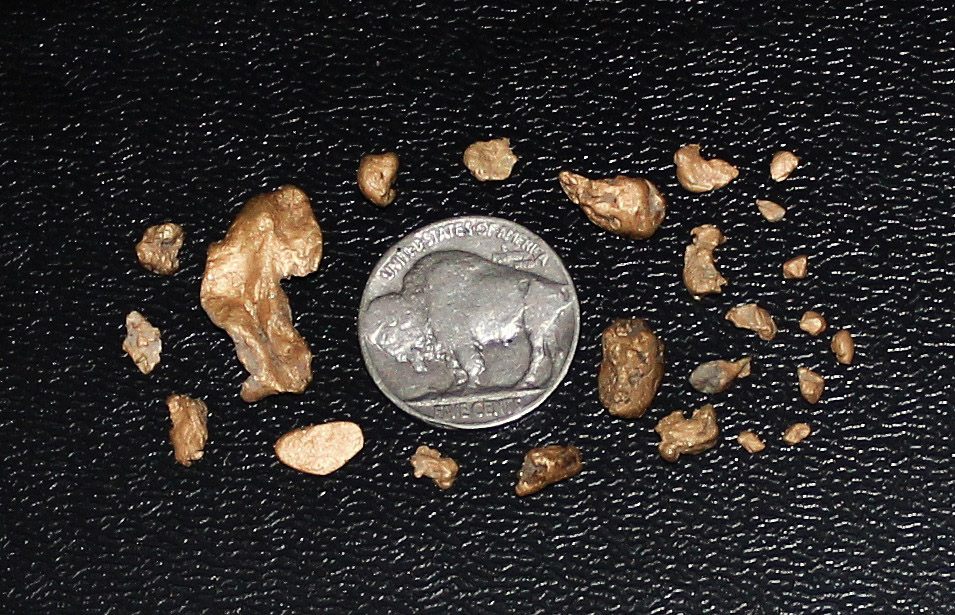Prospecting & Detecting
All About Garnets
February 2013 by Chris Ralph
Just about every experienced prospector has found garnets along with gold in his pan at one time or another. So just why is garnet commonly found with placer gold? What can garnets tell us about mineral deposits? Can they be a tool for exploration? Are they valuable in and of themselves?I get a lot of questions from prospectors about garnets, their value and what they tell us about the geology of some types of mineral deposits. So I thought it would be a good idea to take a closer look at the lowly garnet
 and learn a bit more about it. Some types of mineral deposits commonly contain significant amounts of garnet associated with the ore minerals, so it’s a topic that is worthwhile for prospectors.
and learn a bit more about it. Some types of mineral deposits commonly contain significant amounts of garnet associated with the ore minerals, so it’s a topic that is worthwhile for prospectors.The first thing to learn is that garnet is a family of minerals—not just one mineral species. There are actually six different fairly common minerals that are called garnet and a number of rare ones that also belong to the garnet family. All the members of the garnet family have a related chemical makeup and crystal structure. They are silicates with metals that contribute either two or three electrons to their molecular structure. Metals that can contribute two electrons include calcium, magnesium, manganese and iron. Metals that contribute three electrons in garnet structures include aluminum, iron and chromium. The six best known garnet minerals are almandite, grossular, pyrope, spessartite, andradite and uvarovite. These minerals are only the pure end members of the garnet family, and most garnets found in the field are more complex and certainly not pure. Almost all garnets are mixtures, mostly of the six end members mentioned above.
A typical garnet that one might see in one’s gold pan could be 70% almandine, 20% grossular and 10% pyrope. Common garnet is a mixture of the grossularite, almandite and andradite molecules and occurs in many metamorphosed igneous rocks, schist and some slates. The exact chemical mixture ratios of each garnet can only be determined by chemical analysis. Though garnets differ in composition, all of the kinds crystallize in the same system, and their mineral properties such as hardness, cleavage and density are all very similar. The typical garnet crystals of the common twelve-sided form are known as dodecahedrons.
Garnet exhibits many varieties of color and composition. The color most folks think of in connection with garnet is dark red, but it would be a mistake to suppose this is the only color in which garnet is found. I’ve seen garnet in green, colorless, pink, yellow, orange, purple and brown. Black and near black are also common opaque varieties. The rarest color is blue—only a very few specimens exist. These colors are all, more or less, connected with differences in the chemical composition of the different garnet species as it is the elements that form a garnet that determine its color.
Prospectors find garnets when they are processing gold gravels because garnet is a very common rock forming mineral that is hard and has the power to resist weathering and decay. These properties enable it to endure in gravels long after the other ingredients of the rocks which formed around it have been weathered and worn away. It concentrates with other heavy minerals like magnetite and hematite (black sand) because it is quite dense in comparison with quartz, calcite, feldspar and other rock forming minerals. Garnet that has weathered from various rock types and survived alluvial transport downstream frequently occurs as rounded grains in stream and ocean beach sands. It concentrates with heavy minerals because most garnet is about 3.5 times as heavy as water.
Garnets, when found in crystals, are easily distinguished from other similar appearing minerals by their characteristic round isometric crystals, their hardness, and color. Massive forms of garnet may resemble idocrase, sphene, zircon or tourmaline. It is distinguished from zircon by the fact that it is easier to fuse; and
 from idocrase by its more difficult fusibility; from tourmaline by its higher specific gravity; and from sphene by that mineral’s high titanium content. They vary in the hardness from 6.5 to 7.5 and range in specific gravity from about 3.15 to about 4.3. With a luster that ranges from glassy to resinous, garnets can be found in forms that range from transparent to almost opaque. Sometimes the crystals attain considerable size, and I have seen multi-pound single garnet crystals from numerous places, including Colorado in the US and from India. Some of these large crystals can be spectacular and valuable mineral specimens. The rounded, isometric, 12-sided crystal form is one of the things that prospectors quickly notice. In your gold pan, garnets will often appear as small, rounded, glassy looking balls of a red to orange color (though I have seen them in my pan with a much wider range of colors).
from idocrase by its more difficult fusibility; from tourmaline by its higher specific gravity; and from sphene by that mineral’s high titanium content. They vary in the hardness from 6.5 to 7.5 and range in specific gravity from about 3.15 to about 4.3. With a luster that ranges from glassy to resinous, garnets can be found in forms that range from transparent to almost opaque. Sometimes the crystals attain considerable size, and I have seen multi-pound single garnet crystals from numerous places, including Colorado in the US and from India. Some of these large crystals can be spectacular and valuable mineral specimens. The rounded, isometric, 12-sided crystal form is one of the things that prospectors quickly notice. In your gold pan, garnets will often appear as small, rounded, glassy looking balls of a red to orange color (though I have seen them in my pan with a much wider range of colors).The members of the garnet group occur in many types of rocks and formations and are widely spread in nature. They most commonly occur in schists, slates and other regionally metamorphosed rocks. However, they can also occur in granite, rhyolite and other igneous rocks, and as the product of contact metamorphic forces in limestones. In igneous rocks they are formed by separating from the melt upon slow cooling of the magma. In other igneous rocks they are the products of pneumatolitic hot vapor processes. They are found occasionally in some quartz veins, in pegmatite formations, and associated with other silicates in some types of ore veins. Garnet’s most common and characteristic occurrence is in mica-schists, a rock very commonly associated with gold deposits. This is the source rock type for the garnets most commonly found by prospectors in their search for gold.
I have mentioned the six most common garnet species, so let’s take a look at each of the individual garnet minerals.
Garnet Varieties
Grossularite. It is also sometimes known as essonite or cinnamon stone. Grossularite is a calcium aluminum garnet but often contains ferrous iron replacing some of the calcium and ferric iron replacing part of the aluminum. When pure, the mineral is colorless or white but it is also found as green, yellow, cinnamon-brown, pale red, orange and other tones. The lighter-colored varieties are often transparent or nearly so. Those that are transparent and nicely colored are used as gems. The name is derived from the botanical name for gooseberry, in allusion to the light green color and round shape of the original grossularite. It occurs principally in crystalline schists and in metamorphosed limestones, where it is associated with other calcium silicates. It is also found in some quartz veins. Grossularite occurs as the result of contact metamorphic conditions where limestones are touching granitic rocks.These deposits are known as skarn or tactite and often consist largely of grossularite, epidote, magnetite and pyroxene minerals. In these skarn deposits, grossular garnet is closely associated with tungsten ores and the mineral scheelite. Skarn deposits can also be valuable for copper, iron and gold. The most valuable of the grossularite garnets is a green gem variety known as tsavorite, which is mined in Tanzania, Africa. Good crystals of grossularite occur at Phippsburg, Raymond and Rumford, in Maine, and at many other places in this country, especially around some of the old tungsten mine properties in the West. Colorless and light green varieties have been found in California, and bright yellow varieties are reported from Canyon City, Colorado. Attractive gem and specimen grossularites in a peach-orange color are recovered from the Jeffery asbestos mine in Quebec, Canada.
Pyrope. Pyrope is a magnesium aluminium garnet. Calcium and iron are also normally present in smaller amounts—the pure form of magnesium garnet is unknown. In some specimens chromium replaces part of the aluminum. These types are associated with kimberlite rocks and diamond deposits. Gem grade pyrope associated with the diamond-bearing rocks of South Africa was long sold in the gem trade as “Cape ruby.” The color is normally deep red to nearly black. They are often transparent and those of good red color are used as gems, but this garnet tends to be smaller in size. It occurs principally in basic igneous rocks where it forms on slow cooling of the magma. The name is derived from Greek, meaning “fire like.” Rhodolite is the gem industry trade name given to a pale rose-red to purple garnet mixture that corresponds in composition to two parts of pyrope and one of almandite.
Almandite. Perhaps the most common garnet in the gold fields overall is almandite. It is an iron aluminum garnet, though it is normally impure, and ferric iron often replaces part of the aluminum and magnesium replaces some ferrous iron. The name derived from Alabanda, where in ancient times garnets were cut and
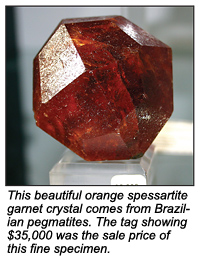 polished. Almandite is deep red, brownish red or black, and ranges from fully transparent to opaque. It is one of the commonest of all garnets, supplying nearly all the material manufactured into abrasives. Transparent varieties with a fine deep red color are also used as gems, and it is the most common of the gem garnets seen in jewelry stores. It is found in granites and andesites and also in some types of ore veins. Though it is very widespread, almandite is best known in the US from occurrences in North America at Yonkers and at various points in the Adirondacks, NY, at Avondale, PA, and on the Stickeen River in Alaska. The almandite of Alaska is used mostly as decorative mineral specimens and is not usually cut into gems as it is too dark and opaque.
polished. Almandite is deep red, brownish red or black, and ranges from fully transparent to opaque. It is one of the commonest of all garnets, supplying nearly all the material manufactured into abrasives. Transparent varieties with a fine deep red color are also used as gems, and it is the most common of the gem garnets seen in jewelry stores. It is found in granites and andesites and also in some types of ore veins. Though it is very widespread, almandite is best known in the US from occurrences in North America at Yonkers and at various points in the Adirondacks, NY, at Avondale, PA, and on the Stickeen River in Alaska. The almandite of Alaska is used mostly as decorative mineral specimens and is not usually cut into gems as it is too dark and opaque.Fine crystals, including some beautiful four ray star garnets are mined at Emerald Creek in northern Idaho. Almandite is also found in India, Brazil, Australia, and several localities in the Alps. Stones from all of these regions are suitable for cutting gems as long as they are of sufficient size and transparency with good color—which includes being not too dark.
Spessartite. Spessartite is a manganese aluminum garnet. In the typical make up, ferrous iron replaces part of the manganese and ferric
 iron replaces part of the aluminum. The color ranges from orange to brownish to garnet-red. The purest varieties are light orange to yellow, but since there is nearly always a mixture in this garnet of one of the iron molecules, the more usual shade is an orange to reddish color. The mineral is usually transparent and is used as a gemstone. It is found in acid igneous rocks and in various schists, but the best specimens come from pegmatites. Spessartite’s best known occurrences in the United States are in granite pegmatites, at Haddam, Connecticut, Ramona, California, and at Amelia Court House, Virginia. They are also found in the lithophyse voids of some rhyolites, such as near Nathrop, in Colorado, near Hayden in Arizona and at Ely, Nevada. Beautiful gem and specimen crystals of spessartite are mined in the pegmatites of Brazil.
iron replaces part of the aluminum. The color ranges from orange to brownish to garnet-red. The purest varieties are light orange to yellow, but since there is nearly always a mixture in this garnet of one of the iron molecules, the more usual shade is an orange to reddish color. The mineral is usually transparent and is used as a gemstone. It is found in acid igneous rocks and in various schists, but the best specimens come from pegmatites. Spessartite’s best known occurrences in the United States are in granite pegmatites, at Haddam, Connecticut, Ramona, California, and at Amelia Court House, Virginia. They are also found in the lithophyse voids of some rhyolites, such as near Nathrop, in Colorado, near Hayden in Arizona and at Ely, Nevada. Beautiful gem and specimen crystals of spessartite are mined in the pegmatites of Brazil.Andradite. Andradite is a calcium iron garnet and one of the more common garnet species, very widely spread across the globe. Aluminium replaces part of the ferric iron and ferrous iron; manganese and magnesium sometimes replace part of the calcium. It occurs in various shades of yellow, green, brown, and brownish red to black. Some rare specimens from Mexico and Nevada have an iridescent sheen on the surface. The purest varieties are topaz-yellow or light green and transparent. The rare but beautiful green variety of andradite is prized as the gem demantoid. These stones have a rich green color, and make beautiful gems when clear and flawless. The name demantoid refers to the diamond-like high light dispersion they possess. The black variety, melanite, nearly always contains titanium. It occurs in alkaline igneous rocks, serpentine, crystalline schists and iron ores. It is named after the Portuguese mineralogist, d’Andrada. The mineral occurs at Franklin, New Jersey, in metamorphosed limestones; near Franconia, New Hampshire, in quartz veins; and at many other places. A black titanium-rich variety occurs in a metamorphosed limestone in southwestern California and near Magnet Cove, in Arkansas.
Uvarovite. Uvarovite is the calcium chromium garnet. The color is always some shade of emerald-green. It makes nice mineral specimens and sees some limited use in the gem trade as drusy, where surfaces covered with small bright green crystals are used directly in jewelry. It is the rarest of the six common and well known garnets, occurring only with chromite deposits, mostly in serpentine. Uvarovite was named after Count Uvarov of Russia. It is found at Bissersk and Kyschtim in the Ural Mountains of Russia; in chromite mines in Texas and Pennsylvania; and in chromium deposits of California as at New Idria.
Uses and Production
The main uses for garnet are as gems, mineral specimens and abrasives. For abrasives, massive garnet deposits of material are crushed and used largely in the manufacture of garnet sand paper. The use of garnet for gem purposes dates back to the earliest times of civilized human history. Among the ornaments adorning the oldest Egyptian mummies are beautiful necklaces containing garnet. The Romans prized the stone highly, and under the name of “carbuncle” it is mentioned in ancient literature all across the world, being noted usually for the brilliant, fiery light which it gives forth. It is still a very popular gemstone today, although its greater abundance in modern times has led to the more common red varieties being less highly prized than centuries ago. Its hardness and durability together with the richness and permanency of its colors give it qualities that are very desirable for a precious stone.The most valuable garnet gems are those that are green in color such as tsavorite and demantoid. Also highly valuable are some garnets from Tanzania, which change color in different types of light in a manner similar to
 the gem alexandrite. After this, the next most valuable garnets are those that are bright and colorful including malaya (a mixed garnet with an orange color range) and rhodolite (a mixed garnet with a purple-red color range). Nice, light-colored sepessartite garnets are dearly prized. Some of the lighter colored yellow to peach grossularite gems are also quite valuable. The darker red stones, including gems of almandite or pyrope, are more common and normally sell for a lesser price.
the gem alexandrite. After this, the next most valuable garnets are those that are bright and colorful including malaya (a mixed garnet with an orange color range) and rhodolite (a mixed garnet with a purple-red color range). Nice, light-colored sepessartite garnets are dearly prized. Some of the lighter colored yellow to peach grossularite gems are also quite valuable. The darker red stones, including gems of almandite or pyrope, are more common and normally sell for a lesser price.One of the things that many prospectors overlook is the value of mineral specimens. Garnet has a high tendency to form well crystallized and attractive mineral specimens. The bright colors contrasted with other minerals or rocks can make for a beautiful and valuable item. I have seen specimens of garnet from Alaska sell for more than $2,000. Other attractive garnet crystal specimens, while not quite as expensive, can be very valuable in their own right.
Prospectors who are searching skarn deposits for gold, copper or tungsten should keep an eye out for well-formed garnet specimens as these may be quite valuable in their own right and worth selling to people who market materials to mineral collectors. I wrote an extensive article about marketing mineral specimens in our May 2012 issue of the ICMJ’s Prospecting and Mining Journal, (“Tucson Show Marketing”).
I often get asked about the value of the garnets prospectors may find. Just about all garnet specimens that are well crystallized and attractive have some value as a mineral specimen. Specimens with cracked, chipped and broken crystals would not have mineral specimen value. To be valuable as a gem, a garnet must have decent size and transparency. This means garnet stones should be at least one quarter inch in diameter and just as transparent as window glass. If the stone has cracks or inclusions of other minerals, it is not valuable as a gemstone. The value of the stone depends on its size and exact color. I would recommend that if you come upon the deposit of gem quality garnet, that you consult with someone who is an expert in raw gemstones to assist you.

Trail to Treasure
 We are both very experienced working this type of ground, and we quickly found the pay layer where we would focus our efforts. The bedrock has good gold, but so does the red hard pan.
We are both very experienced working this type of ground, and we quickly found the pay layer where we would focus our efforts. The bedrock has good gold, but so does the red hard pan.
Modesto, California Man Finds 18-Ounce Nugget
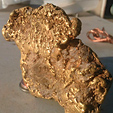 Oscar Espinoza considers himself an amateur gold prospector, but the gold nugget he recently found puts many seasoned prospectors to shame.
Oscar Espinoza considers himself an amateur gold prospector, but the gold nugget he recently found puts many seasoned prospectors to shame.
It's Another 'Ben Day'
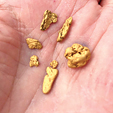 I looked over and saw Ben on his knees, digging at the edge of the Manzanitas, almost underneath them. I thought back to the previous weekend when we were planning this trip—that day had been a “Ben day.”
I looked over and saw Ben on his knees, digging at the edge of the Manzanitas, almost underneath them. I thought back to the previous weekend when we were planning this trip—that day had been a “Ben day.”
Fountain of Youth Gold
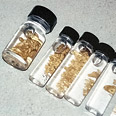 Across and downstream of our operation was a large pile of huge boulders. It was logical to think that water forces may have deposited gold in and around these boulders. We moved our dredge over and started pulling the rock pile apart.
Across and downstream of our operation was a large pile of huge boulders. It was logical to think that water forces may have deposited gold in and around these boulders. We moved our dredge over and started pulling the rock pile apart.
Detecting at the Sixteen to One Mine
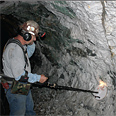 A while back I was given a very special opportunity to take my metal detector to one of the most famous gold mines in all of California, the Original Sixteen to One mine in Alleghany.
A while back I was given a very special opportunity to take my metal detector to one of the most famous gold mines in all of California, the Original Sixteen to One mine in Alleghany.
Detecting A Trashy Area
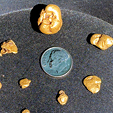 Some prospectors would have assumed it was another shotgun shell, but in this case it was 17.6-pennyweight nugget!
Some prospectors would have assumed it was another shotgun shell, but in this case it was 17.6-pennyweight nugget!
Subscription Required:
The Bawl Mill
• Ask the Experts
• Ask the Experts
• Ask the Experts
• Detecting Old Pocket Diggings
• Refractory Gold Processing
• Detecting in the Outback
• What is a Valid Mineral Discovery?
• Over the Fiscal Cliff for Tax Savings
• Extracting & Smelting Your Gold
• Online Mining Classes Now Available at Mackay
• Heavy Sands Mining
• Melman on Gold & Silver
• Mining Stock Quotes and Mineral & Metal Prices
• Feds Challenge North Idaho Mining Claims


